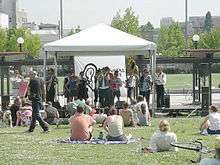Balkan brass
| Balkan brass music | |
|---|---|
| Stylistic origins |
Military music, Folk music |
| Cultural origins | 19th century Serbia |
| Typical instruments | Brass instruments |
| Subgenres | |
| Booty Balkan | |

Balkan brass, popularly known by the Serbian name Truba (Serbian Cyrillic: Труба, "trumpet"), is a distinctive style of music[1] originating in 19th-century Serbia when trumpeters in the military transcribed folk music during harsh times.[2] It is popular throughout the Balkans, especially Serbia, Macedonia and Bulgaria. The beats are usually fast and often accompanied by kolo, a dance. The performers each have their instrument of the orchestra and are called trubači (трубачи). Some of the best known examples of acclaimed music in this style are from Goran Bregović and Boban Marković Orkestar. The Serbian film maker Emir Kusturica has, through his films (Black Cat, White Cat), made the style popular in the international community outside the Balkans.
The biggest brass band event in the world the Guča Trumpet Festival is a 5-day annual festival with 300,000 visitors, in Guča, Serbia.[3]
History
According to many scholars the music genre are imitations of the Mehter music of Ottoman Empire which then evolved in modern Ottoman military bands in 19th century. The eastern melancholic soul of the music is from the oriental melodies which can be seen still today in Turkish clarinet solos. Given the fact that Serbia was once under Ottoman rule, the Balkan brass band tradition is often descended from these bands.
The music's tradition stems from the First Serbian Uprising led by Karageorge in 1815 (Serbian revolution) when Serbs revolted against the occupying Ottoman Empire, eventually liberating Serbia. The trumpet was used as a military instrument to wake and gather soldiers and announce battles, the trumpet took on the role of entertainment during downtime, as soldiers used it to transpose popular folk songs. When the war ended, the soldiers returned to the rural life; the music entered civilian life and eventually became a common musical style, accompanying births, baptisms, weddings, the slava (family patron saint day), farewell parties for those joining military service, state and church festivals, harvesting, reaping, and during funerals of family members in the community. In 1831 the first official military band was formed by Prince Miloš in Belgrade for use in the Serbian Armed Forces. Roma have since adopted the tradition.[2]
The formation of the first military bands in Serbia thus formed the basis of the Balkan brass band traditions and culture.
Instrumentation
A brass band is primarily made up of a large number of musicians playing brass instruments such as flugelhorns, trumpets, alto horns, helicons, euphoniums, tenor horns, tubas, baritone horns, wagner tubas and sometimes trombones. Percussion is provided by snare drum and bass drums, traditionally davuls (also known as tapan or goč) carried by the performers. A few bands occasionally sport clash cymbals, or use a snare drum with a suspended cymbal attachment while most bands attach the cymbals to the bass drum.
The music is usually instrumental although sometimes accompanied with singing. Common song forms include the čoček and the Kolo.
Modern styles
Serbian Brass music has had a major impact on the world music scene. Introduced to western audiences through the films of Emir Kusturica featuring soundtracks by Goran Bregović, it soon spread to European dancefloors spearheaded by DJ Robert Soko's "Balkan Beats" parties in Berlin, Germany.
Traditional bands from Serbia like the Boban Marković Orkestar and from Romania as Fanfare Ciocărlia garnered worldwide attention while new bands like New York-based Balkan Beat Box or the Amsterdam Klezmer Band fused the Balkan sound with other genres like Klezmer or Ska. DJs and producers, most prominently Shantel from Germany, successfully mixed Serbian Brass with electronic beats.
Festivals
- Guča trumpet festival, largest trumpet festival in the world, every year for five days.[3]
- Balkan Trafik, a yearly three-day Balkan Brass festival in Brussels, Belgium.[4]
- Zlatne Uste Golden Festival, a yearly two-day festival in New York City.[5]
- Guča na Krasu - Guča sul Carso, a yearly three-day festival in Trieste.[6]
Popular culture
In movies
- Time of the Gypsies (Dom za vešanje), 1988, Emir Kusturica
- Underground, 1995, Emir Kusturica
- Black Cat, White Cat, 1998, Emir Kusturica
- Borat, 2006
- Trumpets' Republic, 2006, Stefano Missio and Alessandro Gori
- Guca!, 2006, Dusan Milic
Notable Balkan brass bands
- Boban Marković
- Goran Bregović
- Kočani Orkestar
- Fanfare Ciocărlia
- Fejat Sejdić
- Bojan Ristić
- Zlatne Uste
- Slavic Soul Party!
- Raya Brass Band[7]
See also
References
- ↑ "Balkan Brass Bands Music", NationalGeographic.com, archived from the original on 22 September 2012, retrieved 27 September 2012
- 1 2 Mitchell, Laurence (2007). Serbia (2nd ed.). Bradt Travel Guides. Retrieved 27 September 2012.
- 1 2 History at Gucasabor.com
- ↑ Balkan Trafik at MySpace
- ↑ Zlatne Uste Golden Festival 2010
- ↑
- ↑ rayabrassband.com